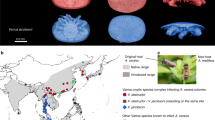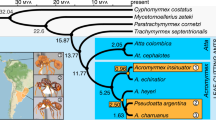Abstract
Ants live in crowded nests with interacting individuals, which makes them particularly prone to infectious diseases. The question is, How do ants cope with the increased risk of pathogen transmission due to sociality? We have studied the molecular evolution of defensin, a gene encoding an antimicrobial protein, in ants. Defensin sequences from several ant species were analyzed with maximum likelihood models of codon substitution to infer selection. Positive selection was detected in the mature region of defensin, whereas the signal and pro regions seem to be evolving neutrally. We also found a significantly higher rate of nonsynonymous substitutions in some phylogenetic lineages, as well as d N /d S > 1, suggesting varying selection pressures in different lineages. Earlier studies on the molecular evolution of insect antimicrobial peptide genes have focused on termites and dipteran species, and detected positive selection only in duplicated termicin genes in termites. These findings, together with our present results, provide an indication that the immune systems of social insects (ants and termites) and dipteran insects may have responded differently to the selection pressure caused by microbial pathogens.



Similar content being viewed by others
References
Anisimova M, Bielawski JP, Yang Z (2002) Accuracy and power of Bayes prediction of amino acid sites under positive selection. Mol Biol Evol 19:950–958
Baer B, Schmid-Hempel P (1999) Experimental variation in polyandry affects parasite loads and fitness in a bumblebee. Nature 397:151–154
Baer B, Schmid-Hempel P (2001) Unexpected consequences of polyandry for parasitism and fitness in the bumblebee, Bombus terrestris. Evolution 55:1639–1643
Boniotto M, Tossi A, DelPero M, Sgubin S, Antcheva N, Santon D, Masters J, Crovella S (2003) Evolution of the beta defensin 2 gene in primates. Genes Immun 4:251–257
Brady SG, Schultz TR, Fisher BL, Ward PS (2006) Evaluating alternative hypotheses for the early evolution and diversification of ants. Proc Natl Acad Sci USA 103:18172–18177
Bromham L, Leys R (2005) Sociality and the rate of molecular evolution. Mol Biol Evol 22:1393–1402
Bulmer MS, Crozier RH (2004) Duplication and diversifying selection among termite antifungal peptides. Mol Biol Evol 21:2256–2264
Bulmer MS, Crozier RH (2006) Variation in positive selection in termite GNBPs and Relish. Mol Biol Evol 23:317–326
Christe P, Oppliger A, Bancala F, Castella G, Chapuisat M (2003) Evidence of collective medication in ants. Ecol Lett 6:19–22
Chapuisat M, Opplinger A, Magliano P, Christe P (2007) Wood ants use resin to protect themselves against pathogens. Proc R Soc London B 274:2013–2017
Cornet B, Bonmatin J-M, Hetru C, Hoffman JA, Ptak M, Vovelle F (1995) Refined three-dimensional solution structure of insect defensin A. Structure 3:435–448
Cremer S, Armitage SAO, Schmid-Hempel P (2007) Social immunity. Curr Biol 17:R693–R702
Da Silva P, Jouvensal L, Lamberty M, Bulet P, Caille A, Vovelle F (2003) Solution structure of termicin, an antimicrobial peptide from the termite Pseudacanthotermes spiniger. Protein Sci 12:438–446
Evans JD, Aronstein K, Chen YP, Hetru C, Imler J-L, Jiang H, Kanost M, Thompson GJ, Zou Z, Hultmark D (2006) Immune pathways and defence mechanisms in honey bees Apis mellifera. Insect Mol Biol 15:645–656
Ferrandon D, Imler JL, Hetru C, Hoffmann JA (2007) The Drosophila systemic immune response:sensing and signalling during bacterial and fungal infections. Nat Rev Immunol 7:862–874
Froy O, Gurevitz M (2003) Arthropod and mollusk defensins—evolution by exon-shuffling. Trends Genet 19:684–687
Goldman N, Yang Z (1994) A codon-based model of nucleotide substitution for protein-coding DNA sequences. Mol Biol Evol 11:725–736
Goropashnaya AV, Fedorov VB, Pamilo P (2004) Recent speciation in the Formica rufa group ants (Hymenoptera, Formicidae): inference from mitochondrial DNA phylogeny. Mol Phylogenet Evol 32:198–206
Goropashnaya AV, Fedorov VB, Seifert B, Pamilo P (2007) Phylogeography and population structure in the ant Formica exsecta (Hymenoptera, Formicidae) across Eurasia as reflected by mitochondrial DNA variation and microsatellites. Ann Zool Fenn 44:462–474
Hasegawa E, Tinaut A, Ruano F (2002) Molecular phylogeny of two slave-making ants: Rossomyrmex and Polyergus (Hymenoptera:Formicidae). Ann Zool Fenn 39:267–271
Hollox EJ, Al Armour J (2008) Directional and balancing selection in human beta-defensins. BMC Evol Biol 8:113
Hughes AL, Nei M (1988) Pattern of nucleotide substitution at major histocompatibility complex class I loci reveals overdominant selection. Nature 335:167–170
Hughes AL, Yeager M (1997) Coordinated amino acid changes in the evolution of mammalian defensins. J Mol Evol 44:675–682
Hughes AL, Hughes MK, Howell CY, Nei M (1994) Natural selection at the class II major histocompatibility complex loci of mammals. Philos Trans R Soc Lond B 346:359–367
Hughes WOH, Boomsma JJ (2004) Genetic diversity and disease resistance in leaf-cutting ant societies. Evolution 58:1251–1260
Jiggins FM, Kim K-W (2005) The evolution of antifungal peptides in Drosophila. Genetics 171:1847–1859
Jiggins FM, Kim K-W (2007) A screen for immunity genes evolving under positive selection in Drosophila. J Evol Biol 20:965–970
Johnson RN, Agapow P-M, Crozier RH (2003) A tree island approach to inferring phylogeny in the ant subfamily Formicinae, with especial reference to the evolution of weaving. Mol Phylogenet Evol 29:317–330
Klaudiny J, Štefan A, Bachanová K, Kopernický J, Šimúth J (2005) Two structurally different defensin genes, one of them encoding a novel defensin isoform, are expressed in honeybee Apis mellifera. Insect Biochem Mol 35:11–22
Kosakovsky Pond SL, Frost SDW (2005a) Datamonkey:rapid detection of selective pressure on individual sites of codon alignments. Bioinformatics 21:2531–2533
Kosakovsky Pond SL, Frost SDW (2005b) Not so different after all: a comparison of methods for detecting amino acid sites under selection. Mol Biol Evol 22:1208–1222
Kosakovsky Pond SL, Muse SV (2005) Site-to-site variation of synonymous substitution rates. Mol Biol Evol 22:2375–2385
Kosakovsky Pond SL, Frost SDW, Muse SV (2005) HyPhy: hypothesis testing using phylogenies. Bioinformatics 25:676–679
Kumar S, Tamura K, Nei M (2004) MEGA3: integrated software for Molecular Evolutionary Genetics Analysis and sequence alignment. Brief Bioinform 5:150–163
Lazzaro BP, Clark AG (2003) Molecular population genetics of inducible antibacterial peptide genes in Drosophila melanogaster. Mol Biol Evol 20:914–923
Li W-H (1993) Unbiased estimation of the rates of synonymous and nonsynonymous substitution. J Mol Evol 36:96–99
Liersch S, Schmid-Hempel P (1998) Genetic variation within social insect colonies reduces parasite load. Proc R Soc London B 265:221–225
Luenser K, Ludwig A (2005) Variability and evolution of bovine β-defensin genes. Genes Immun 6:115–122
Lynn DJ, Lloyd AT, Fares MA, O’Farrelly C (2004) Evidence of positively selected sites in mammalian α-defensins. Mol Biol Evol 21:819–827
Maget-Dana R, Ptak M (1997) Penetration of the insect defensin A into phospholipid monolayers and formation of defensin A-lipid complexes. Biophys J 73:2527–2533
McDonald JH, Kreitman M (1991) Adaptive protein evolution at the Adh locus in Drosophila. Nature 351:652–654
Moreau CS, Bell CD, Vila R, Archibald B, Pierce NE (2006) Phylogeny of the ants:Diversification in the age of angiosperms. Science 312:101–104
Morrison GM, Semple CAM, Kilanowski FM, Hill RE, Dorin JR (2003) Signal sequence conservation and mature peptide divergence within subgroups of the murine β-defensin gene family. Mol Biol Evol 20:460–470
Muse SV, Gaut BS (1994) A likelihood approach for comparing synonymous and nonsynonymous substitution rates, with application to the chloroplast genome. Mol Biol Evol 11:715–724
Nicholas KB, Nicholas HB (1997) GeneDoc: a tool for editing and annotating multiple sequence alignments. Distributed by the authors
Nielsen R, Yang Z (1998) Likelihood models for detecting positively selected amino acid sites and applications to the HIV-1 envelope gene. Genetics 148:929–936
Nylander JAA (2004) MrModeltest 2.2. Program distributed by the author. Evolutionary Biology Centre. Uppsala University, Uppsala, Sweden
Palmer KA, Oldroyd BP (2003) Evidence for intra-colonial genetic variance in resistance to American foulbrood of honey bees (Apis mellifera): further support for the parasite/pathogen hypothesis for the evolution of polyandry. Naturwissenschaften 90:265–268
Pamilo P, Bianchi NO (1993) Evolution of the Zfx and Zfy genes: rates and interdependence between the genes. Mol Biol Evol 10:271–281
Parmakelis A, Slotman MA, Marshall JC, Awono-Ambene PH, Antonio-Nkondjio C, Simard F, Caccone A, Powell JR (2008) The molecular evolution of four anti-malarial immune genes in the Anopheles gambiae species complex. BMC Evol Biol 8:79
Patil A, Hughes AL, Zhang G (2004) Rapid evolution and diversification of mammalian α-defensins as revealed by comparative analysis of rodent and primate genes. Physiol Genomics 20:1–11
Rice P, Longden I, Bleasby A (2000) EMBOSS: the European Molecular Biology Open Software Suite. Trends Genet 16:276–277
Robinson-Rechavi M, Huchon D (2000) RRTree: relative-rate tests between groups of sequences on a phylogenetic tree. Bioinformatics 16:296–297
Ronquist F, Huelsenbeck JP (2003) MrBayes 3:Bayesian phylogenetic inference under mixed models. Bioinformatics 19:1572–1574
Rothenbuhler WC (1964) Behavior genetics of nest cleaning in honey bees. IV. Responses of F1 and backcross generations to disease-killed brood. Am Zool 4:111–123
Rozas J, Sanchez-DelBarrio JC, Messeguer X, Rozas R (2003) DnaSP, DNA polymorphism analyses by the coalescent and other methods. Bioinformatics 19:2496–2497
Sackton TB, Lazzarro BP, Schlenke TA, Evans JD, Hultmark D, Clark AG (2007) Dynamic evolution of the innate immune system in Drosophila. Nature Genet 39:1461–1468
Schlenke TA, Begun DJ (2003) Natural selection drives Drosophila immune system evolution. Genetics 164:1471–1480
Schmid-Hempel P (1998) Parasites in social insects. Princeton University Press, Princeton, NJ
Schmid-Hempel P, Crozier RH (1999) Polyandry versus polygyny versus parasites. Philos Trans R Soc Lond B 354:507–515
Schmidt HA, Strimmer K, Vingron M, von Haeseler A (2002) TREE-PUZZLE:maximum likelihood phylogenetic analysis using quartets and parallel computing. Bioinformatics 18:502–504
Seeley TD, Tarpy DR (2007) Queen promiscuity lowers disease within honeybee colonies. Proc R Soc London B 274:67–72
Semple CAM, Rolfe M, Dorin JR (2003) Duplication and selection in the evolution of primate β-defensin genes. Genome Biol 4:R31
Simard F, Licht M, Besansky NJ, Lehmann T (2007) Polymorphism at the defensin gene in the Anopheles gambiae complex:Testing different selection hypotheses. Infect Genet Evol 7:285–292
Steiner FM, Schlick-Steiner BC, Schödl S, Espadaler X, Seifert B, Christian E, Stauffer C (2004) Phylogeny and bionomics of Lasius austriacus (Hymenoptera, Formicidae). Insect Soc 51:24–29
Swofford DL (2002) PAUP*. Phylogenetic Analysis Using Parsimony (*and other methods). Version 4. Sinauer Associates, Sunderland, MA
Tarpy DR (2003) Genetic diversity within honeybee colonies prevents severe infections and promotes colony growth. Proc R Soc London B 270:99–103
Thompson JD, Higgins DG, Gibson TJ (1994) Clustal-W—improving the sensitivity of progressive multiple sequence alignment through sequence weighting, position-specific gap penalties and weight matrix choice. Nucleic Acids Res 22:4673–4680
Trowsdale J, Parham P (2004) Defense strategies and immunity-related genes. Eur J Immunol 34:7–17
Van Baalen M, Beekman M (2006) The costs and benefits of genetic heterogeneity in resistance against parasites in social insects. Am Nat 167:568–577
Viljakainen L, Pamilo P (2005) Identification and molecular characterization of defensin gene from the ant Formica aquilonia. Insect Mol Biol 14:335–338
Yang Z (2007) PAML 4: phylogenetic analysis by maximum likelihood. Mol Biol Evol 24:1586–1591
Yang Z, Nielsen R, Goldman N, Pedersen A-MK (2000) Codon-substitution models for heterogeneous selection pressure at amino acid sites. Genetics 155:431–449
Zhang J, Rosenberg HF, Nei M (1998) Positive Darwinian selection after gene duplication in primate ribonuclease genes. Proc Natl Acad Sci USA 95:3708–3713
Acknowledgments
We would like to thank Riitta Jokela for technical assistance, Sylvia Cremer and Ross Crozier for comments on the manuscript, Francis Jiggins for useful discussions, and Christian Bernasconi, Daniel Cherix, Sylvia Cremer, Ross Crozier, Patrizia D’Ettorre, David Hughes, Perttu Seppä, and Alberto Tinaut for provision of samples. This project was supported by grants from the Academy of Finland (1211489 and 122210).
Author information
Authors and Affiliations
Corresponding author
Rights and permissions
About this article
Cite this article
Viljakainen, L., Pamilo, P. Selection on an Antimicrobial Peptide Defensin in Ants. J Mol Evol 67, 643–652 (2008). https://doi.org/10.1007/s00239-008-9173-6
Received:
Revised:
Accepted:
Published:
Issue Date:
DOI: https://doi.org/10.1007/s00239-008-9173-6




